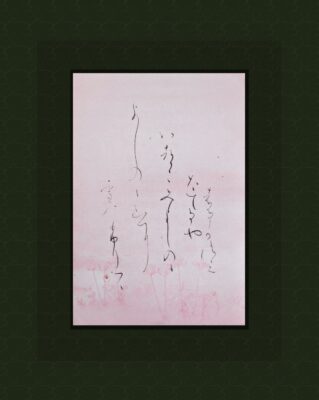#188 Where on earth is spring haze?

| Size: | 33×24 cm |
|---|---|
| Dressing: | framed |
What kind of verse?
| verse: | haru gasumi, tate ru ya izuko, mi-yoshino no, yoshino no yama ni, yuki ha furi tsutsu |
|---|---|
| (imho): | Where on earth is spring haze? Even though it snows repeatedly in the mountains of Yoshino. |
| poet: | unknown |
| in: | before 913 |
brief comment
Where exactly did the poet compose this poem?
In fact, there are two theories regarding where this poem was composed: one suggests it was written in Yoshino Mountain in Nara, and the other suggests it was written in the capital (Kyoto). Let’s delve a bit into each theory.
The Theory that it was Composed in Yoshino Mountain in Nara: presence
Yoshino Mountain has been renowned as a famous spot for cherry blossoms since ancient times, and many poems have been written about it.
Many poems touch on landscapes and the changes of seasons, delicately depicting the specific scenery of the place. If we consider that this poem was composed in Yoshino Mountain, the description of the scene becomes more concrete and immediate.
The Theory that it was Composed in the Capital (Kyoto): The Yearning of the Capital’s Inhabitants
During the Heian period, the nobility harbored a yearning for Yoshino Mountain, and many poems were composed about it without actually visiting the place.
It’s also possible to interpret that people living in Kyoto composed this poem while imagining the distant Yoshino Mountain from the capital.
The fact that it is labeled as “title unknown” and “author unknown” suggests there might be a reason behind it, making it more convincing that it was composed not by simply describing the scenery in Yoshino.
Conclusion
Both theories have merit regarding where this poem was composed. The theory that it was composed in Yoshino Mountain aligns with the detailed description of the scenery and suggests it was based on actual experience. On the other hand, the theory that it was composed in the capital reflects the tradition of the Heian nobility’s yearning for Yoshino Mountain and the practice of imagining and depicting distant landscapes.
Which theory one supports depends on how one interprets the background of the poem, the culture of the time, and the poet’s intentions. Nevertheless, isn’t it wonderful that a poem composed over 1100 years ago provides us with a theme that we can still ponder and get excited about today?

